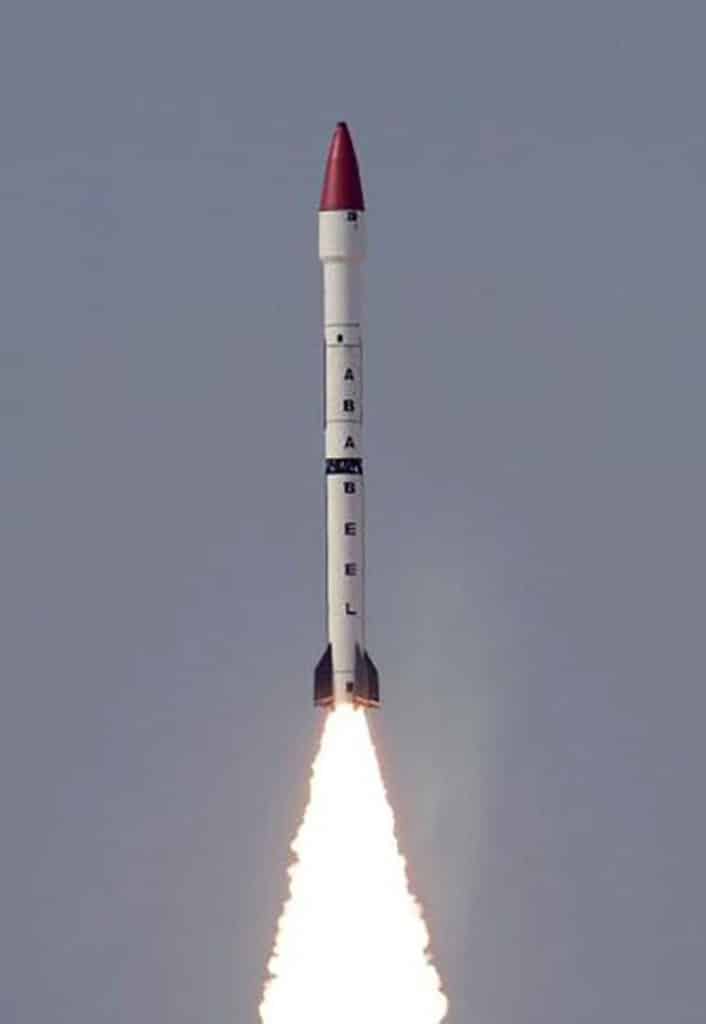The Ababeel is Pakistan’s first surface-to-surface medium range ballistic missile (MRBM), reportedly capable of carrying Multiple Independently Targetable Re-entry Vehicles (MIRVs). The three-stage, solid-fuel missile was unveiled in a test on January 24, 2017.
Ababeel at a Glance
- Originated from
- Pakistan
- Possessed by
- Pakistan
- Class
- Medium-range ballistic missile (MRBM)
- Basing
- Road-mobile
- Length
- Unknown
- Diameter
- 1.7 m (est.)
- Warhead
- Nuclear, Conventional
- Payload
- Multiple independently targetable reentry vehicle (MIRV)
- Propulsion
- Solid-fuel
- Range
- 2,200 km
- Status
- In development
- In service
- N/A

An Ababeel test launch in January 2017. Photo: ISPR Pakistan
Ababeel Development
Development of the Ababeel most likely began during the mid to late 2000s. Its basic design shares many characteristics with Pakistan’s other solid fuel MRBMs, such as the Shaheen II and Shaheen III, as well as China’s CSS-7 SRBM. In 2010, the BBC reported that Pakistani engineers, with Chinese assistance, were “in the advance stages of developing MIRV technology.”1 MIRV, an acronym for multiple independently targetable reentry vehicles, is a technology that allows a single missile to carry multiple warheads, each individually programmed to attack different targets.
Flight Test
The Ababeel’s only known flight test took place on January 24, 2017. The missile was launched from a site in Winder, on the southern coast of Pakistan. Based on the missile flight range safety zone issued in a Notice to Mariners by the Pakstani Navy on January 21, 2017, one analyst noted the farthest distance the Ababeel could have flown was 1100 km at a maximum altitude of 500 km.2
This distance fell well short of the missile’s reported maximum range of 2,200 km, indicating that the test’s purpose could have been to evaluate other aspects of the missile’s design. A press release from Pakistan’s Inter Services Public Relations office underlined that rather than flying to maximum range, “the test flight was aimed at validating various design and technical parameters of the weapon system.”3
It is unclear if the Ababeel’s purported MIRV technology was employed during the test.
Specifications
The Ababeel is a three-stage, solid-fuel medium-range ballistic missile with a reported maximum range of 2,200 km.4 While the length of the missile is unknown, the swollen nose cone section of the missile is estimated to be 1.7 m in diameter.5 Pakistan’s claim that Ababeel uses MIRV technology has not be verified and remains a point of debate. Reports indicate the missile can be outfitted with both nuclear and conventional warheads.
MIRV Doubts
Some experts have expressed skepticism as to whether Pakistan has indeed surmounted the various technological hurdles required for MIRVed missiles. MIRV warheads are typically much smaller than unitary warheads, and thus require greater miniaturization. It is unclear if the country has manufactured a miniaturized nuclear warhead small enough to use in a MIRV.6 The missile’s larger nose-cone section, however, may be an attempt to compensate for a lack of warhead miniaturization.
Another obstacle, the development of a Post-Boost Control Vehicle or ‘bus’, requires, “expertise in design and fabrication of small thrusters, fabrication of propellant and gas tanks, precision fabrication of valves, high-pressure plumbing, quality control and storable liquid propellants” that Pakistan may lack.7
Pakistan has, nonetheless, demonstrated other important MIRV-related technologies in the past. These notably include the capability to field small, liquid-fueled retrograde stabilizing rockets for a post separation attitude control system (PSAC). Pakistan has reportedly deployed PSAC on its Shaheen 1, Shaheen 1A, and Shaheen 2 missiles.8 If Pakistan has overcome these obstacles, it is unlikely it did so without foreign support. China, which likely tested its first MIRVed missile only a few days after the Ababeel’s flight, is suspected of providing Pakistan with technical support.9
Regional Implications
Since 2010, numerous analysts have weighed in on the consequences of MIRV proliferation in Asia.10 The introduction of multiple-warhead missiles to southern Asia may have a destabilizing effect on regional security. Vipin Narang, associate professor of Political Science at MIT and member of MIT’s Security Studies program, said after the missile’s test launch, “it is hard to deny that India and Pakistan are in a full-blown arms race.”11 According to Pakistan’s Inter Service Public Relations office, the development of a MIRV capable missile is “aimed at ensuring survivability of Pakistan’s ballistic missiles in the growing regional Ballistic Missile Defense (BMD) environment.”12
Footnotes
- Syed Shoaib Hasan, “Pakistan’s growing nuclear programme,” BBC, December 1, 2010, http://www.bbc.com/news/world-south-asia-11888973; Franz-Stefan Gady, “Pakistan tests new ballistic missile capable of carrying multiple nuclear warheads,” The Diplomat, January 25, 2017, http://thediplomat.com/2017/01/pakistan-tests-new-ballistic-missile-capable-of-carrying-multiple-nuclear-warheads/.
- Rajaraam Nagappa, “Does Pakistan’s Ababeel Medium Range Ballistic Missile Really Have MIRV Capability?” Delhi Defense Review (blog), February 3, 2017, http://www.delhidefencereview.com/2017/02/03/does-pakistans-ababeel-medium-range-ballistic-missile-really-have-mirv-capability/; Pakistan Navy, Notice to Mariners, January 21, 2017, https://www.paknavy.gov.pk/NTMs/20170121NTM-03.pdf.
- Inter Services Public Relations, Press Release, January 24, 2017, https://www.ispr.gov.pk/front/main.asp?o=t-press_release&id=3705&search=1.
- Inter Services Public Relations, Press Release, January 24, 2017, https://www.ispr.gov.pk/front/main.asp?o=t-press_release&id=3705&search=1.
- Nagappa.
- Ibid.
- Ibid
- Richard Fisher Jr., “Pakistan’s Long Range Ballistic Missiles: A View From IDEAS,” International Assessment and Strategy Center, November 1, 2004, http://www.strategycenter.net/research/pubid.47/pub_detail.asp; “Ballistic Haft IV Test Fired” Dawn, April 25, 2012, https://www.dawn.com/news/713388.
- Bill Gertz, “China Tests Missile with 10 Warheads,” Washington Free Beacon, January 31, 2017, http://freebeacon.com/national-security/china-tests-missile-10-warheads/; Syed Shoaib Hasan, “Pakistan’s growing nuclear programme,” BBC, December 1, 2010, http://www.bbc.com/news/world-south-asia-11888973.
- Michael Krepon, “The Second Coming of MIRVs,” Arms Control Wonk, May 12, 2016, http://www.armscontrolwonk.com/archive/1201367/the-second-coming-of-mirvs/; Zachary Keck, “Breaking the nuclear gridlock: it’s time to ban land-based MIRVs,” Bulletin of Atomic Scientists, June 17, 2014, http://thebulletin.org/breaking-nuclear-gridlock-it%E2%80%99s-time-ban-land-based-mirvs7245; New York Times Editorial Board, “China Buys into Multiple Warheads,” New York Times, May 20, 2015, https://www.nytimes.com/2015/05/20/opinion/china-buys-into-multiple-warheads.html.
- Ankit Panda, “Why Pakistan’s Newly Flight-Tested Multiple Nuclear Warhead-Capable Missile Really Matters,” The Diplomat, January 25, 2017, http://thediplomat.com/2017/01/why-pakistans-newly-flight-tested-multiple-nuclear-warhead-capable-missile-really-matters/.
- Inter Services Public Relations, “No PR 34/2017 ISPR,” Press Release, January 24, 2017https://www.ispr.gov.pk/front/main.asp?o=t-press_release&cat=army&date=2017/1/24.